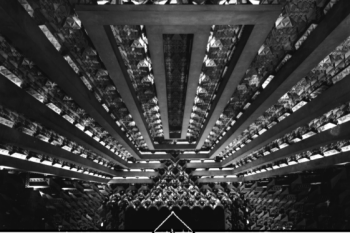
| From Cosmic City to Esoteric Cinema: Pythagorean Mathematics and Design in Australia |
|---|
(Sydney, Australia)41 Forbes Street
Newtown, NSW 2042 AUSTRALIA
Pythagorean design in Australia began not with the short-lived Pythagorean Society at Sydney (1913) but with the international competition for the plan of Canberra (1912). The winning entry by Chicago architects Walter Burley and Marion Mahony Griffin was a visionary scheme for a cosmic city formed on a St Andrew's cross suggested by the natural topography. At the crossing of the principal 'Land' and 'Water' axes they described a circle of a mile radius, thus forming the fundamental mandala of the new Federal Capital. The resulting symbol of circle and cross resembles the ancient Egyptian hieroglyph for a city or town.
The formative circle crosses the Land Axis at the two main ceremonial centres of Canberra, the parliamentary complex on Capital Hill and the people's Casino (now the site of the Australian War Memorial). Additional circles of the same radius, centred on these two sites, complete the major 'Pythagorean Triad' which links these ceremonial centres with a classical and very appropriate symbolism. A similar Triad connects the proposed three centres of government on Capital Hill. Thus, ninety years after reaching Australia, the secret plan of Canberra, with its Pythagorean geometry and esoteric symbolism, is finally revealed.

Capitol Theatre, Melbourne, view of auditorium with the "crystal tetraktys" above the proscenium. Harold Paynting Collection, State Library of Victoria
The mandala of circle and cross determines much else of inner
Canberra as well as the geometry of several other Griffin plans,
including their most important Australian buildings, Newman College
and the Capitol Theatre in Melbourne. The latter, Australia's
first skyscraper, houses an extraordinary cinema auditorium dominated
by ziggurat forms, a 'Crystal Tetraktys' and other Pythagorean
symbols which relate the Melbourne Capitol to the unbuilt Capitol
of Canberra. This central parliamentary monument was to have
been a grand temple-theatre ziggurat, representing a democratic
vision of Greek ideals. The Melbourne Capitol reworked this vision
in microcosm - in another theatre-temple with ziggurat forms
and the mathematics of the Tetraktys reflected in the harmonic
proportions of the building and with other Pythagorean decorative
motifs.
Thus the crystalline forms and Pythagorean geometry of the Melbourne Capitol echo the original design and esoteric symbolism of Canberra, so beautifully envisioned in Marion Griffin's 'City and Environs' painting.
ABOUT THE AUTHOR
Graham Pont, a specialist in interdisciplinary studies, taught
in the General Education programme at the University of New South
Wales for thirty years. Here he introduced the world's first
undergraduate courses in Gastronomy (1978-88). He was a founding
convener of the Symposium of Australian Gastronomy (1984) and
co-editor of Landmarks of Australian Gastronomy (1988). His last
appointment was a visiting professorship in the School of Science
and Technology Studies, UNSW (1996-99). Trained in philosophy,
his principal research area has been history and philosophy of
music but his interests have also extended to environmental studies,
landscape, history of gardening, philosophy of technology, bio-acoustics
and wine history. He recently published the results of the first
major computer analysis of Handel's music and he is completing
a biography of Australia's first composer and musicologist, Isaac
Nathan (1792-1864). A long study of Pythagorean ideas has proved
unexpectedly relevant to his latest enthusiasm: the design philosophy
of Walter Burley and Marion Mahony Griffin.
A Rome Scholar in architecture, Peter
Proudfoot is Visiting Professor in the Faculty of the
Built Environment, University of New South Wales, Australia.
In articles and books he has written on the origin and history
of Australian cities, the effect of seaport development on city
growth and urban construction, the theory and practice of the
Picturesque movement, ancient geomantic paradigms and their influence
on modern urban planning, and architectural education theory.
He was a consultant to the National Estate Division of the Australian
Government on the conservation of historic structures, a consultant
to the Commission of Inquiry into the Maritime Industry and the
Australian Development Corporation.
|
Graham Pont and Peter Proudfoot, "From Cosmic City to Esoteric Cinema", pp. 195-206 in Nexus IV: Architecture and Mathematics, eds. Kim Williams and Jose Francisco Rodrigues, Fucecchio (Florence): Kim Williams Books, 2002. http://www.nexusjournal.com/conferences/N2002-Proudfoot-Pont.html |
|
|
|
|
